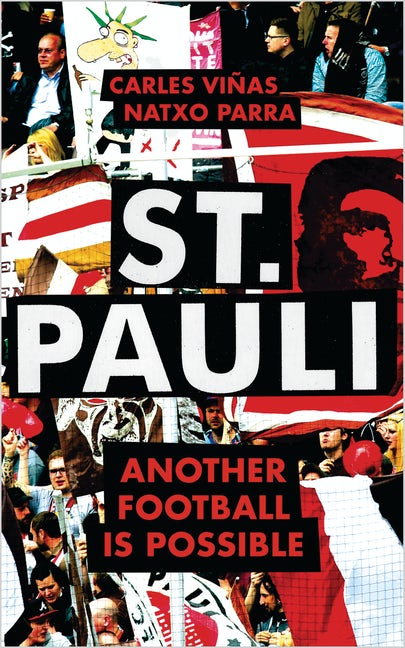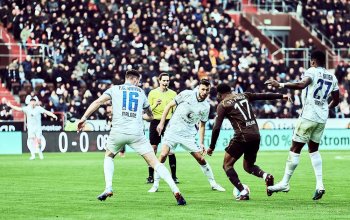Ein neues Buch über den FC St. Pauli? – Leg es zu den anderen! Oder doch nicht?
Am Dienstag, 20.Oktober, erscheint ein neues Buch über den FC St. Pauli. Mal wieder, möchte man meinen. Genauer gesagt erscheint jedoch die englische Übersetzung des bereits 2017 auf Spanisch veröffentlichten Buches: „FC St. Pauli“ von Natxo Parra und Carles Viñas. Das nun veröffentlichte Exemplar in englischer Sprache erhebt den Anspruch, insbesondere die erweiterte internationale Leser*innenschaft über die Geschichte und den Geist des „Cult clubs“ zu informieren, der erfolgreich den Versuchungen des modernen Fußballs widersteht. Es umfasst nebst eines Vorwortes von Deniz Naki und einer Einleitung rund 241 Seiten über den Verein im Laufe der Zeit. Der Millernton hat es bereits für Euch gelesen und sagt Euch, ob und für wen sich die Lektüre lohnen könnte.
Bibliographische Informationen: Parra, Natxo/ Viñas, Carles (2020). “St. Pauli. Another Football is Possible.” London: Pluto Press.
Bestellen könnt Ihr das Buch übrigens am besten direkt bei PlutoPress als Paperback (eBook gibt es dann gratis dazu) oder als reines eBook. Mit dem Code BRAUNWEISS20 erhaltet Ihr 20% Rabatt.
Und das allerbeste: Unter allen Fans, die uns bis heute um 19.10h in die Kommentare schreiben, wie hoch genau wir gegen Nürnberg gewinnen, verlosen wir drei Frei-Exemplare (bitte daher eine gültige e-mail Adresse angeben).
(Die Verlosung ist rum, Glückwünsch an Luquer, Knurri & Mel.)
Zuerst einmal gefällt, dass der Titel dieser englischen Übersetzung offenbar nicht der Abscheulichkeit des typischen deutschen Sachbuchformats eines catchy titles und einer dann irgendwie sich selbst beantwortenden Frage folgt. Stattdessen trägt das Buch den simplen Titel “St. Pauli“ und den ebenso vielversprechenden Untertitel „Ein anderer Fußball ist möglich.“ (Im deutschen würde das Buch vermutlich mit dem Titel: „Einzigartiger Kultclub St. Pauli. Wie ein Verein aus Hamburg einen anderen Fußball ermöglicht“ erscheinen…). Das Buch startet dann in der vertrauten Herangehensweise eines informierten Sachbuchs, durch chronologische Aufarbeitung. Es ist in insgesamt fünf Teile gegliedert, die von den Anfängen des Vereins im 19. Jahrhundert, dem Verein unter dem Hakenkreuz, den Anfängen der Freibeuter*innen der Liga in den 1980er Jahren, Tribünen mit aufkeimendem politischen Bewusstsein und schließlich der wachsenden Attraktivität eines politischen Vereins über die Landesgrenzen hinweg berichten.
Was steht drin?

Natürlich können und wollen wir hier nicht den gesamten Inhalt des Buches widergeben, schließlich soll das Buch ja auch noch seine Käufer*innen finden. Ein paar Dinge, die den Inhalt aber ganz gut widerspiegeln, werden wir hier trotzdem kurz schildern.
So lernt man denn beim Lesen auch einiges über die Anfänge des „englischen Sports“ in Deutschland, der zunächst noch als moralisch verwerflich keine Mehrheiten hinter sich versammeln konnte. Ebenfalls wird der Ursprung und die Geschichte Hamburgs und dann konkreter St. Paulis erörtert. Detailliert arbeiten die Autoren so heraus, wie St. Pauli maßgeblich durch den Hafen und die damit verbundenen Jobs als Arbeiter*innenstadtteil im 19. Jahrhundert erwacht, während diejenigen, die es sich leisten können, in die Elbvororte verziehen. Das ist für mit dem Viertel Vertraute natürlich nicht viel Neues; der internationalen Leserschaft, die vielleicht nicht ganz mit dem Lokalkolorit und der Geschichte Hamburgs vertraut ist, mag es jedoch sinnvolle Hintergrundinformationen über Land und Leute und politische Vergangenheiten des Stadtteils eröffnen. Auch dass Fußball im Verein auf St. Pauli bereits weit vor 1910 gespielt wurde, nämlich im St. Pauli Turnverein, bleibt natürlich nicht unerwähnt.
Sehr detailgetreu wird dann auch die Geschichte des FCSP von seinen Anfängen als bourgoiser Verein, der Fußball unter dem Hakenkreuz, sowie der Fußball vor Einführung der Bundesliga und die 1960er und 1970er Jahre nachgezeichnet und über wichtige Persönlichkeiten im jeweiligen Kontext berichtet. Dennoch: so richtig Fahrt nimmt das Buch natürlich erst dann auf, wenn in den bewegten 1980er Jahren, der revolutionäre Impuls der Hafenstraßenbesetzer*innen und damit auch die Totenkopf-Fahne Einzug auf die Tribünen am Millerntor erhalten und diese Tatsachen zeitgeschichtlich eingeordnet werden. So berichten die Autoren wissenschaftlich informiert über die gesellschaftspolitische Dimension von Hausbesetzungen sowie die deutsche Anti-Atomkraftbewegung. Fortan galt der FC St. Pauli als anderer Entwurf eines Fußballvereins bzw. St. Pauli-Unterstützer*innen als andere Typen von Fans innerhalb der Fußballlandschaft, auch wenn dieser Status erst noch – teilweise gegen den Willen der bis dato etablierten Fans – durchgesetzt werden musste. Nicht umsonst gab es schließlich den sogenannten Hafenstraßenblock auf der Gegengerade, eben weil hier noch Platz war und bestehende Fangruppierungen hier nicht verdrängt werden mussten. Denn die standen damals bekanntlich ja noch auf der Nördkurve (sic!). Ob es dieser charmante Übersetzungsfehler auch in die am Dienstag erscheinende Ausgabe geschafft hat, bleibt abzuwarten. Uns lag zur Rezension lediglich die zur Korrektur vorgesehene Druckfahne vor und dieser Begriff, der sich so konsequent durch das Buch zieht, lockte beim Lesen jedes Mal ein Lächeln hervor. In den folgenden Kapiteln wird anschließend die voranschreitende Demokratisierung des Clubs und seiner Abteilungen beschrieben sowie das soziale Engagement der Fanszene und einiger Spieler (Stichwort: Benny Adrion und Marius Ebbers) erörtert.
Ein weiterer wichtiger Aspekt wird im Buch dann mit dem Aufkommen der Ultra-Bewegung beschrieben, das eine weitere Zäsur auf den Tribünen des Millerntors darstellte. Sorgfältig wird dabei die Entstehung der Ultra-Gruppierungen im italienischen Kontext vorgestellt, deren politischen Verflechtungen dargelegt und geschildert, wie sich diese dann in die Variante als Ultra Sankt Pauli am Millerntor formierten. Sehr aufschlussreich.
Ebenfalls hervorgehoben wird, dass der FC St. Pauli mit durchschnittlich 30% weiblicher Unterstützerinnen im Stadion weltweite Spitzenwerte einnimmt. Was für uns eher selbstverständlich erscheint, wird von den Autoren durch das klare anti-sexistische Bekenntnis der Fanszene erklärt, das neben anti-faschistischen, anti-homophoben und anti-rassistischen Attributen hervorgehoben wird. Dass dieses anti-sexistische Engagement auch bis heute noch aktiv auf den Tribünen durchgesetzt werden muss, wird hingegen nicht erwähnt. Dennoch folgerichtig widmet sich dann auch das 17. Kapitel dem Frauenfußball am Millerntor von seinen Anfängen bis zur aktuellen Situation (zwar bis dato mit nur einem Fanclub, auch wenn es derer ja heute mindestens zwei gibt!).
Weitere Aufmerksamkeit erhalten dann auch die vielfältigen internationalen Fanclubs des FC St. Pauli, die im Buch an Beispielen speziell aus England, Schottland, Irland und Spanien vorgestellt werden. Was aus Enttäuschung über den mehr und mehr kommerzialisierten Fußball im jeweiligen Heimatland entstand, trägt mit vielfältigem karitativem Engagement mittlerweile sehr begrüßenswerte Früchte und regt zu Nachahmungen an.
Wie ist das Buch einzuordnen?
Das Werk verfolgt bei seiner Darstellung prinzipiell einen dualen Ansatz. Neben der zeitgeschichtlichen Dimension der Stadt Hamburg und des Stadtteils St. Pauli wird auch stets die sportliche Geschichte des Clubs mit abgebildet. So werden die Geschichten namhafter Figuren am Millerntor nachgezeichnet, sowie das eher moderate sportliche Abschneiden des Vereins in den verschiedensten Ligen im Lauf der Jahrzehnte beschrieben. Da das Buch in spanischer Sprache bereits 2017 erschien, endet es in seiner Darstellung mit Ewald Lienen als Trainer, auch der Derbysieg von 2011 wird natürlich noch als einzigartiges Ereignis nach 30-jähriger Durststrecke beschrieben…
Generell muss man über das Buch anmerken, dass es eher einer wissenschaftlichen Publikation gleicht, denn einem simplen Sachbuch. Sämtliche Darstellung erscheinen breit recherchiert und sind mit vielfältigen Quellennachweisen versehen. Was einerseits sehr zu befürworten ist, weil die mitunter in Fußnoten fortgeführten Seitenstränge ausführlich mit Quellenverweisen versehen sind, stört andererseits dennoch mitunter den Lesefluss ein wenig. Wer darüber hinaus sämtliche Fußnoten aufmerksam liest, wird sich zuweilen über die doch erheblichen Redundanzen wundern. Aber Redundanzen sind ja bekanntlich auch von didaktischem Nutzen 😉
Für wen eignet sich das Buch?
Wer meint schon alles über den Verein zu wissen, bisher aber noch kein Buch über den Verein gelesen hat, wird sicherlich noch den ein oder anderen Sachverhalt entdecken, der überrascht. Somit lohnt sich das Buch auch für langjährige Supporter*innen. Ob es mit seinem Detailwissen jedoch auch solcher Leser*innen zu Fans machen wird, die bisher nichts oder nur wenig über den Verein wussten, ist ob der Detailfülle des Werkes fraglich, weil die vielfältigen Informationen teilweise auch erschlagend wirken können. Beim Lesen habe ich mich zudem gefragt, ob das Buch eigentlich weitestgehend deskriptiv bleibt, der wissenschaftliche Anspruch schreit doch förmlich nach etwas mehr analytischer Einordnung. Doch genau die erfolgt am Ende im Epilog auf sehr befriedigende Weise, wenn der moderne Fußball kritisch analysiert wird und mit der Marxschen Entfremdung, Habermascher Refeudalisierung der öffentlichen Sphären sowie der kulturellen Hegenomie von Gramsci in Zusammenhang gebracht und mit einer würzigen Kritik des Neoliberalismus versehen wird. Das hat dann auch den soziologischen Nerd (Nörd!) in mir beruhigt. Daher kann ich guten Gewissens eine klare Leseempfehlung aussprechen. Auch der Verein erhält mit diesem Buch ein zukünftiges Standardwerk, das sich sehr zur Vermittlung der Werte des Vereins für nicht-deutschsprachige Spieler eignet und vielleicht bei künftigen Neuverpflichtungen einfach mit in den Spint in der Kabine gelegt werden sollte, damit es zukünftigen Spielern besser ergeht als einst Andreas Boller 1992 (um diesen Hinweis verstehen zu können, empfiehlt sich insbesondere die Lektüre von Kapitel 9…). // Arne
Alle Beiträge beim MillernTon sind gratis. Wir freuen uns aber sehr, wenn Du uns unterstützt.
MillernTon auf BlueSky // Mastodon // Facebook // Instagram // Threads // WhatsApp // YouTube
{:}{:en}A new book about FC St. Pauli? – Put it to all the other ones! Or not, though?
On Tuesday, 20th October, a new book about FC St. Pauli is published. Again, one is triggered to say. But to be more precise, the English translation of the book „FC St. Pauli“ by Natxo Parra and Carles Viñas, already published in Spanish in 2017, is being published on that day. The English-language copy claims to especially inform the extended international readership about the history and spirit of the „cult club“, which successfully resists the temptations of modern football. Beside a preface by Deniz Naki and an introduction, the book consists of 241 pages about the club in the course of time. The Millernton did already read the book for you and tells you whether the book is worth a read and for whom.
Bibliographical information: Parra, Natxo/ Viñas, Carles (2020). “St. Pauli. Another Football is Possible.” London: Pluto Press.
You can order your copy directly at PlutoPress either as a paperback (which will include a free eBook) or as a pure eBook only. If you use the code BRAUNWEISS20, you’ll get a 20% discount.
And the very best: Amongst all fans who comment until 7.10 pm (German time) today how high we’re going to win against Nuremberg, we’ll raffle three copies of the book (thus, please provide a valid email address).
(Raffle is over, congratulations to Luquer, Knurri & Mel.)
First of all, I like the fact that the title of this English translation apparently does not follow the abomination of the typical German non-fiction format of a catchy title and then a question that somehow answers itself. Instead, the book is simply titled “St. Pauli“ combined with the very promising subtitle „Another football is possible.“ (In the German language, the book would probably be titled: „The unique cult club St. Pauli. How a club from Hamburg enables another football“…). The book then begins in the familiar approach of an informed non-fictional book, through chronological processing. It is divided into a total of five parts which tell of the beginnings of the club in the 19th century, the club under the swastika, the beginnings of the Pirates of the League in the 1980s, stands with burgeoning political awareness, and finally the growing attractiveness of a political clubs across national borders.
What’s in the book?

Of course, we cannot reflect the entire content of the book within this review, simply because the book deserves to get bought. However, we’ll tell briefly about a few things which reflect the content pretty well.
As such, while reading along, one learns a few things about the beginnings of the „English game“ in Germany, which was first not backed by a majority because it was deemed to be a moral hazard. Also, the origin and the history of Hamburg and even more precisely St. Pauli is discussed. In detail, the authors work out how St. Pauli decisively awakens through the harbour and the associated jobs as a labourer’s city district in the 19th century while those who can afford it move to the Elbe suburbs. For those familiar with the district, that’s of course not much news; however, for the international readership which might not be as familiar with the districts spleens and history, the book might offer reasonable background information about the city and its people as well as the political past of the district. Also, that football was played in a club in St. Pauli well before 1910, namely in the St.Pauli gymnastics club, is of course not untold.
The history of the FCSP from its beginnings as a bourgeois club, its football under the swastika, as well as its football before the introduction of the Bundesliga in the 1960s and 1970s is traced in great detail. Also, the book reports about important personalities in their respective contexts. Nevertheless, the book will only really pick up speed when the revolutionary impulse of the Hafenstraße squatters* and with it, the Jolly-Roger-flag are brought to the stands at Millerntor in the eventful 1980s. These facts are then placed in the context of contemporary history. Backed by proper research, the authors report about the socio-political dimension of squatting as well as the German anti-nuclear-power movement. From then on, FC St. Pauli was regarded as having a different approach towards football and their supporters as other types of fans within the football landscape, even though this status had yet to be enforced – partly against the will of the established fans. It was not for nothing that the so-called Hafenstraßenblock was finally set up on the Gegengerade, precisely because there was still space available and the other existing fan groups did not have to be displaced from there. As we all know, those guys were still standing in the Nördkurve (sic!). Whether this charming translator’s error will also be published in the final edition of the book has yet to be waited for. For this review, we were provided with the uncorrected proof of the book and this term, which was constantly appearing throughout the book, was always triggering a smile in my face (see below why). In the following chapters, the ongoing process of democratisation of the club and its departments is described, as well as the social engagement of the fan scene and certain players respectively (e.g. Benny Adrion or Marius Ebbers).
Another important aspect is then described with the appearance of the Ultra-movement which marked another turning point on the stands of the Millerntor. In a very detailed manner, the development of Ultra sections in the Italian context, and their political linkages are described and it’s portrayed, how Ultra Sankt Pauli (USP) formed at the Millerntor. Very informative.
It’s also emphasised in the book that with an average of 30%, the FC St. Pauli’s is amongst the world-leading clubs in regards of female supporters in the stands. What appears rather obvious for us is explained with the clear anti-sexist statement of the fan scene by the authors which is particularly highlighted next to anti-fascist, anti-homophobic and anti-racist attributes. That a clear stance against sexist behaviour in the stands has still to be enforced actively up to the day is however not mentioned by the authors. The 17th chapter of the book dedicates itself to women’s football at the Millerntor from its beginning up till today (However, in the book, only one particular fan-club of the women’s team is mentioned although there are at least two nowadays!).
Further attention is paid to the emergence of diverse international fan-clubs of the FC St. Pauli over the years which are introduced by describing those from England, Scotland, Ireland and Spain. What arose out of disappointment about the increasingly commercialised football in the respective home country, is now bearing very welcomed fruits with a variety of charitable activities which encourage imitation.
How should the book be classified?
In principle, the book follows a dual approach. In addition to the contemporary historical dimension of the city of Hamburg and the St. Pauli district, the sporting history of the club is always included. Thus, the stories of well-known figures at the Millerntor are traced, as well as the rather moderate sporting performance of the club in various divisions over the decades. As the book was already published in Spanish in 2017, it ends in its presentation with Ewald Lienen as coach, also the derby victory of 2011 is of course still described as a unique event after 30 years of hard times…
In general, the book is more like a scientific publication than a simple non-fiction book. All the illustrations appear broadly researched and are provided with numerous references. What is very much to be welcomed on the one hand, because the page strands, sometimes continued in footnotes, are extensively provided with source references, on the other hand nevertheless sometimes disturbs the flow of reading a little bit. Anyone who reads all the footnotes carefully will sometimes be surprised at the considerable number of redundancies. However, redundancies are also well-known for their didactic benefit 😉
Who is the book for?
Those who think they already know everything about the club, but have not yet read a book about it, will certainly discover some surprising facts. Thus, the book is also worthwhile for long term supporters. However, whether its detailed knowledge will turn even those readers into fans who previously knew little or nothing about the club is questionable, as the wealth of detail in the work can sometimes be overwhelming. While reading it, I also wondered whether the book actually remained largely descriptive, as the scientific claim literally cries out for a bit more of analytical classification. But this is precisely what happens in the epilogue in a very satisfying way, when modern football is critically analysed and associated with Marx’s alienation, Habermas’s refeudalisation of public spheres and Gramsci’s cultural hegemony, and provided with a spicy critique of neoliberalism. That then also calmed my inner sociological nerd (Nörd! This term sounds like a Hamburg slang term of „nerd“ to a German ear and thus always triggered a smile to my face as written above). With a clear conscience, I can therefore make a clear reading recommendation. With this book, the club also receives a future standard work which is very suitable for conveying the values of the club to non-German-speaking players and which should perhaps be placed in the locker in the dressing room when new players are signed in the future, so that future players are better off than Andreas Boller was in 1992 (in order to be able to understand this reference, it is particularly recommended that you read chapter 9…).
//Arne
MillernTon Twitter //
MillernTon YouTube //
MillernTon Facebook //MillernTon Instagram //
If you like what we do here, here you’ll find the information on how to support us.
{:}




3:1
3:1 für die kultigen Boys In Brown!
LG
Es gibt ein ganz biederes 1:1
Mit besten Grüßen
Frank
Klarer 3:1 Sieg!
Wird knapp, aber Torreich: 3:2.
Das wird ein 2:1 Sieg für die braun weissen ..
1:0 für die Guten, Forza
Zu spät gelesen für die Verlosung.
Zum letzten Absatz: Dabei gabe es doch damals schon -Bücher für Boller-